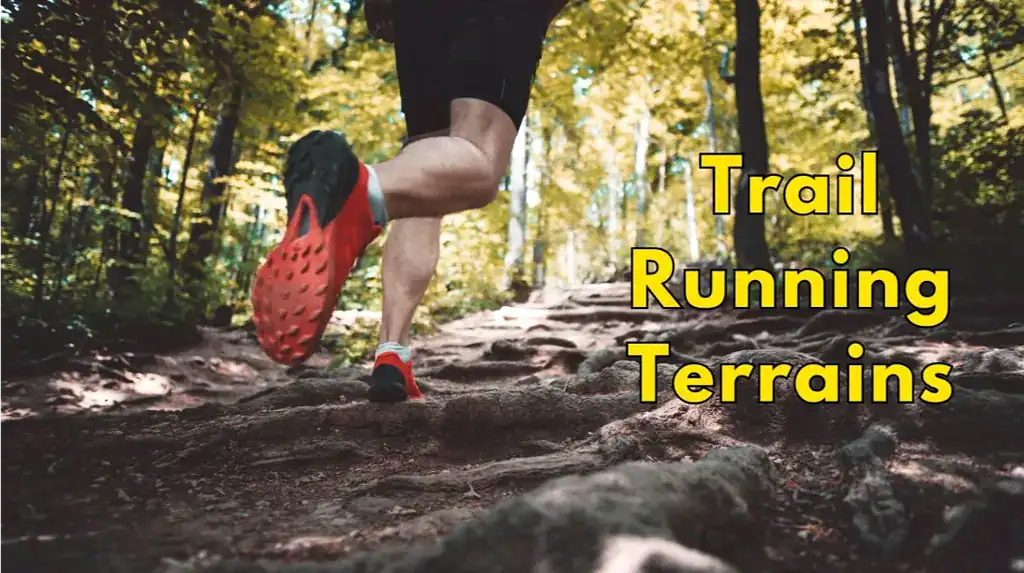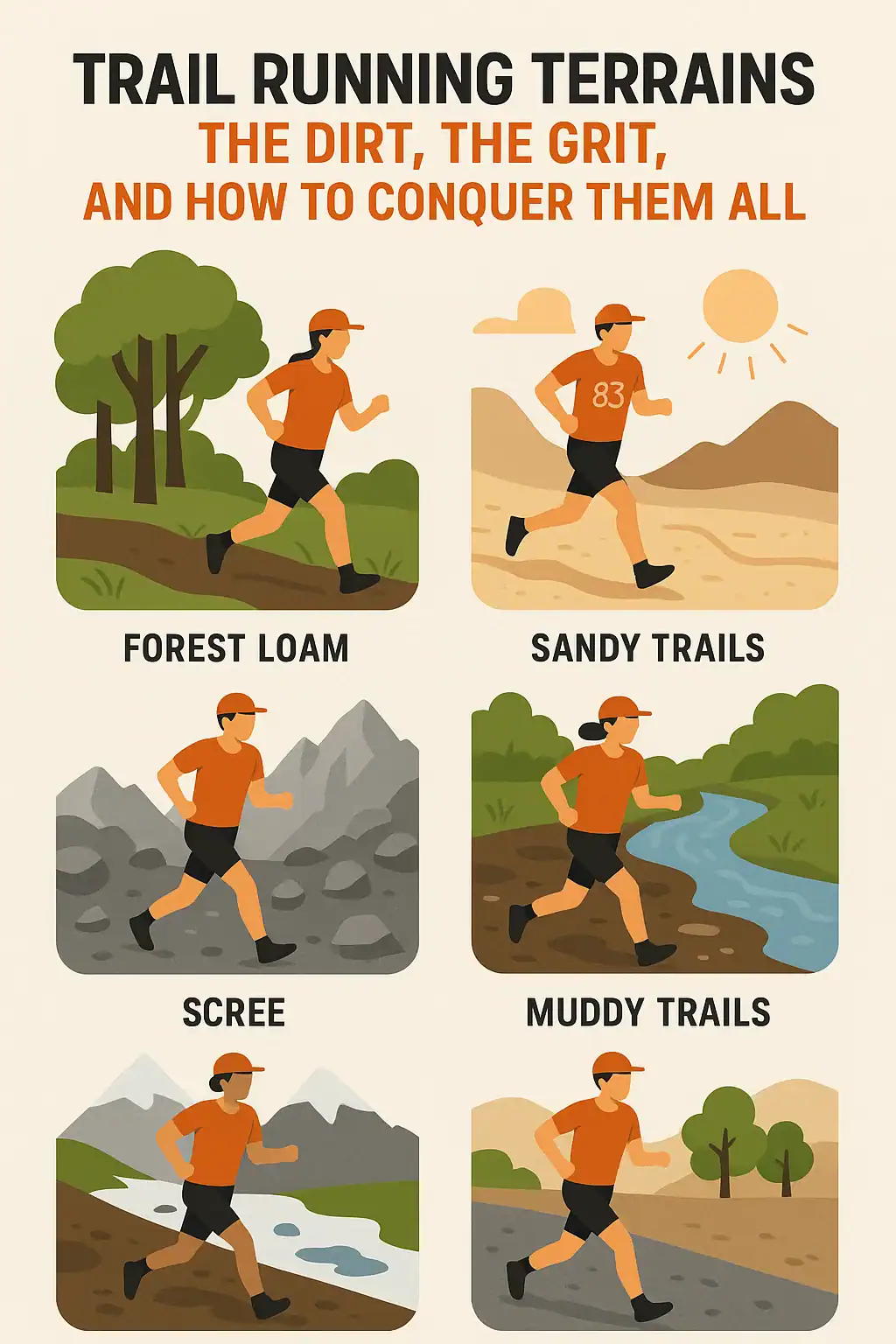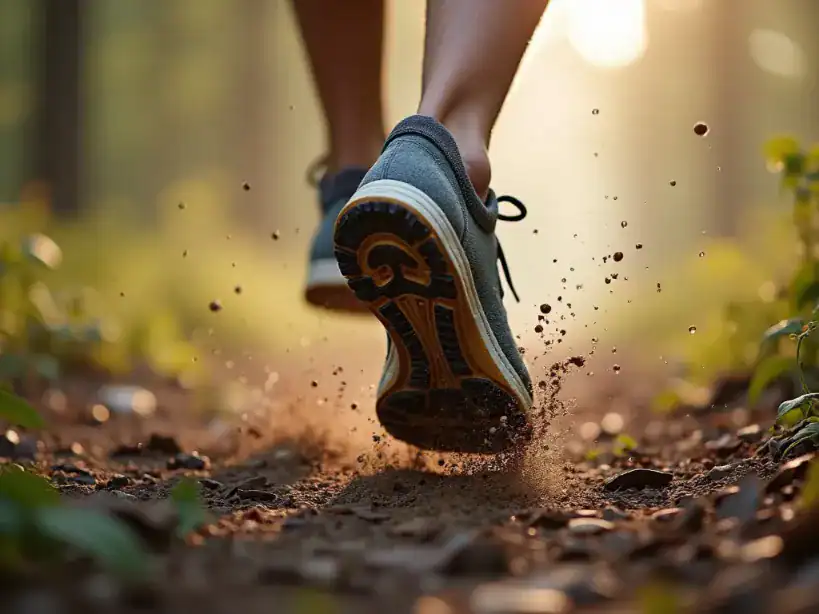How do you run on different trail terrains? To run on varied trails, you need specific gear, adapted technique, and terrain-specific knowledge. This guide details the six major surfaces—from forest loam to alpine scree—and provides the actionable steps to master them safely by 2026.
🔑 Key Takeaways
- Master 6 Surfaces: From soft forest loam to technical rock, each terrain demands a unique strategy.
- Choose Shoes by Terrain: Use aggressive lugs for mud, rock plates for scree, and low-profile for hardpack.
- Adapt Your Technique: Shorten stride uphill, quick steps downhill, and scan 10-15 feet ahead on technical ground.
- Prioritize Essential Gear: A hydration vest, navigation tool (like a Garmin Fenix 8), and moisture-wicking socks are non-negotiable.
- Start Simple, Progress Smart: Begin on gravel fire roads before attempting technical mountain trails.
- Safety is Foundational: Always research conditions, carry a first-aid kit, and inform someone of your route.
Understanding trail running terrains transforms your run. It’s about respecting the wild, mastering your movement, and building a profound connection with the outdoors. This guide turns you from a tentative newcomer into a terrain-savvy veteran.
Understanding Different Trail Running Terrains
The ground offers a spectrum of surfaces. Each has its own personality and demands. You learn to read them. It’s a continuous dialogue between runner and route.
Forest Loam and Leafy Trails
Dappled sunlight through a green canopy. The path is soft—a mix of decaying leaves, pine needles, and rich soil. Forest loam is a forgiving surface.
It cushions impact and can be fast. Your feet may sink slightly, offering gentle resistance that builds subtle strength. It’s ideal for finding rhythm. Hidden roots and wet leaves are the primary hazards. A seemingly dry patch can become a slip hazard. This terrain provides excellent low-impact cardio.
PERSONAL EXPERIENCE: On a run in the Pacific Northwest, the ground felt like a springy carpet. I was flying. Then a slick patch of wet leaves under a dry spot sent me into a stumble. A muddy hip was the reminder: the trail always has the last word.
Sandy Trails and Desert Paths
Running on sand is a unique challenge. It saps energy. Your feet sink, and your calves work overtime. Each step is a negotiation. Loose sand absorbs force like a sponge. Packed sand on coastal or desert trails can be firm and runnable.
Desert routes often mix sand with rocky sections. The sun is relentless. Hydration is critical. Consider these trails advanced fitness training. Mastering proper breathing techniques is essential here.
Scree, Boulders, and Technical Ascents
This is where trail running earns its stripes. Technical trails are littered with rocks—from ankle-twisting scree to stable boulders. Foot placement is a rapid-fire game of chess.
You must look ahead, picking your line. Your ankles and core work overtime. Uphills become a scramble; downhills a controlled fall. This is where rugged shoes with rock plates, like the Salomon Speedcross 6, are mandatory. The reward is immense accomplishment and raw outdoor activity.
Muddy Trails and River Crossings
Mud is the great equalizer. After rain, trails transform. Mud can be slick, greasy, and calf-deep. It challenges balance and steals traction.
River crossings add complexity. Will you rock-hop or wade? Each choice has consequences. Muddy runs test your gear, patience, and humor. You need shoes with aggressive lugs, like the Inov-8 Mudclaw. You will probably fall. It’s part of the primal, challenging connection to the elements.
Alpine Trails and Mountain Running
Above the treeline, the world changes. The air is thin. Views are staggering. Alpine trails are rocky, exposed, and subject to sudden weather shifts. You may encounter summer snow patches.
Climbs are lung-busting. Descents are quad-shredding. This requires serious fitness, mountain sense, and precise gear. Proper nutrition and hydration are non-negotiable here. This is the pinnacle for many trail runners.
Gravel Roads and Fire Trails
Not all trails are singletrack. Gravel roads and fire trails offer a different experience. They are wider with uniform surfaces—crushed rock or hardpack dirt.
They are great for mileage, steady-state runs, or a taste of trail without extreme technicality. They provide consistent hill training. They can be dusty or harsh over long distances. A solid option for predictable terrain.
Essential Kit for Varied Terrains
Your gear is your partner. Choose for function, not fashion.
Shoes: Your First Line of Defense
The right trail running shoes are critical. They are not beefed-up road shoes. They have specific features for specific terrains.
| Feature | Soft/Forest Loam | Sandy Trails | Rocky/Technical | Muddy Trails | Gravel/Fire Roads |
|---|---|---|---|---|---|
| Cushioning | Moderate | Moderate to Max | Moderate to Max | Moderate | Moderate to Max |
| Outsole Lugs | Moderate | Low to Moderate | Aggressive | Deep, Spaced | Moderate |
| Rock Plate | Optional | Optional | Recommended | Optional | Optional |
| Upper | Breathable | Breathable | Durable | Water-resistant | Durable |
| Stability | Neutral | Neutral/Stable | Stable | Stable | Neutral/Stable |
When choosing terrain, how trail running shoes should fit is paramount. A bad fit causes blisters. Brands like Brooks and Nike offer models for varied conditions, but fit is king.
Beyond the Feet: Other Gear
- Socks: Merino wool or synthetic. No cotton. Blisters are the enemy.
- Hydration Pack/Vest: Essential for remote or exposed trails. The Salomon Adv Skin 12 is a top choice for 2026.
- Navigation: Phone with GPS, map, or a dedicated watch like the Garmin Instinct 2 Solar.
- Layers: Weather changes fast. A lightweight shell is mandatory for alpine runs.
- Sun Protection: Hat, sunglasses, SPF 50+ sunscreen for desert and alpine running.
Trail Running Techniques for Every Surface
Trail running is a skill. It’s a dynamic dance with the ground.
Mastering the Uphills
Shorten your stride. Use your arms. Lean into the hill from your ankles. On steep sections, power hiking is more efficient than running. This is where your cardio capacity is tested.
Conquering the Downhills
Stay relaxed. Look 10-15 feet ahead, not at your feet. Take shorter, quicker steps. Use your arms for balance. Let gravity help, but stay in control. On technical descents, caution prevents serious falls.
Navigating Obstacles: Roots, Rocks, and Rivers
Lift your feet. Practice scanning the trail ahead. For river crossings, assess depth and current. Unclip your pack’s waist belt in case you fall. These tips prevent nasty spills.
Choosing the Right Trail Running Terrains For You
Not all trails suit all runners. Honesty about your ability is key.
Beginner-Friendly Trails
Start with well-maintained, less technical paths. Think crushed gravel or gentle forest trails. Focus on comfort on uneven surfaces. Build confidence on clearly marked, manageable routes.
Challenging Your Limits
With basics down, seek technical terrain, long climbs, and remote adventures. Your fitness training pays off here. Always practice trail safety—tell someone your plan. Exploring different types of trail running maintains motivation.
Trail Running Safety Across Terrains
The wild is beautiful and unforgiving.
Research and Preparation
Check 2026 weather forecasts. Study the route on Gaia GPS or AllTrails. Understand the terrain. Pack the Ten Essentials. Tell someone your plans. Proper trail running advice starts with preparation.
On-Trail Smarts
Be aware. Watch for wildlife. Carry a small first-aid kit. Know basic navigation. Don’t take unnecessary risks alone. If you feel unwell or weather turns, turn back. The trail will be there tomorrow. Respect the environment.
More Than Just a Run
Running on different terrains is a mental game. It’s problem-solving. It’s about mud, sweat, and resilience. It’s also about the silence of the forest and the vast mountain view. You find a tougher version of yourself on the trail. It’s a gritty, beautiful, and addictive pursuit.
Conclusion
Trail running terrains are diverse, challenging, and rewarding. Each surface teaches you about running and yourself. It’s not always easy. But the effort and joy of moving through wild places is special. Gear up with the right shoes, master the techniques, prioritize safety, and get out there. The trails are waiting.
Your next step: Audit your current shoes. Are they matched to your most-run terrain? Plan one run this month on a surface you usually avoid to build versatility.
❓ Frequently Asked Questions
What is the best all-around trail running terrain for beginners?
Start on well-groomed gravel fire roads or packed dirt single-track. These surfaces are predictable, allow you to focus on form, and minimize technical hazards like roots and rocks, building confidence safely.
Can I use my road running shoes on hardpack dirt trails?
For short distances on very smooth, hardpack trails, you might get away with it. However, road shoes lack the traction, protection, and stability for true trail running. Investing in a dedicated pair like the Hoka Speedgoat 5 is recommended for safety and performance.
How do I safely run downhill on technical, rocky terrain?
Stay relaxed, look ahead (not at your feet), and take short, quick steps to maintain balance. Use your arms for stability. Lean slightly forward and let gravity assist, but be prepared to slow down or side-step unstable rocks. Practice on moderate slopes first.
What’s the single most important piece of gear for alpine trail running?
Beyond proper shoes, a reliable navigation and communication device is critical. The Garmin inReach Mini 3 allows for GPS tracking and SOS signaling in remote, exposed alpine environments where weather can change rapidly and cell service is nonexistent.
How often should I replace my trail running shoes?
Replace trail shoes every 300-500 miles. Aggressive terrain wears down lug depth and midsole cushioning faster than road running. If you notice significant tread wear, decreased traction, or joint discomfort, it’s time for a new pair.
References
- American Trail Running Association (ATRA) – Trail News & Safety
- Runner’s World – Technical Trail Running Guide
- REI Expert Advice – Trail Running Fundamentals
- iRunFar – Ultramarathon & Trail Culture Analysis
- National Park Service – Trail Condition Reports
- Outdoor Project – United States Trail Running Guides
- Trail Run Project – Crowdsourced Trail Data & Maps
Alexios Papaioannou
Mission: To strip away marketing hype through engineering-grade stress testing. Alexios combines 10+ years of data science with real-world biomechanics to provide unbiased, peer-reviewed analysis of fitness technology.



